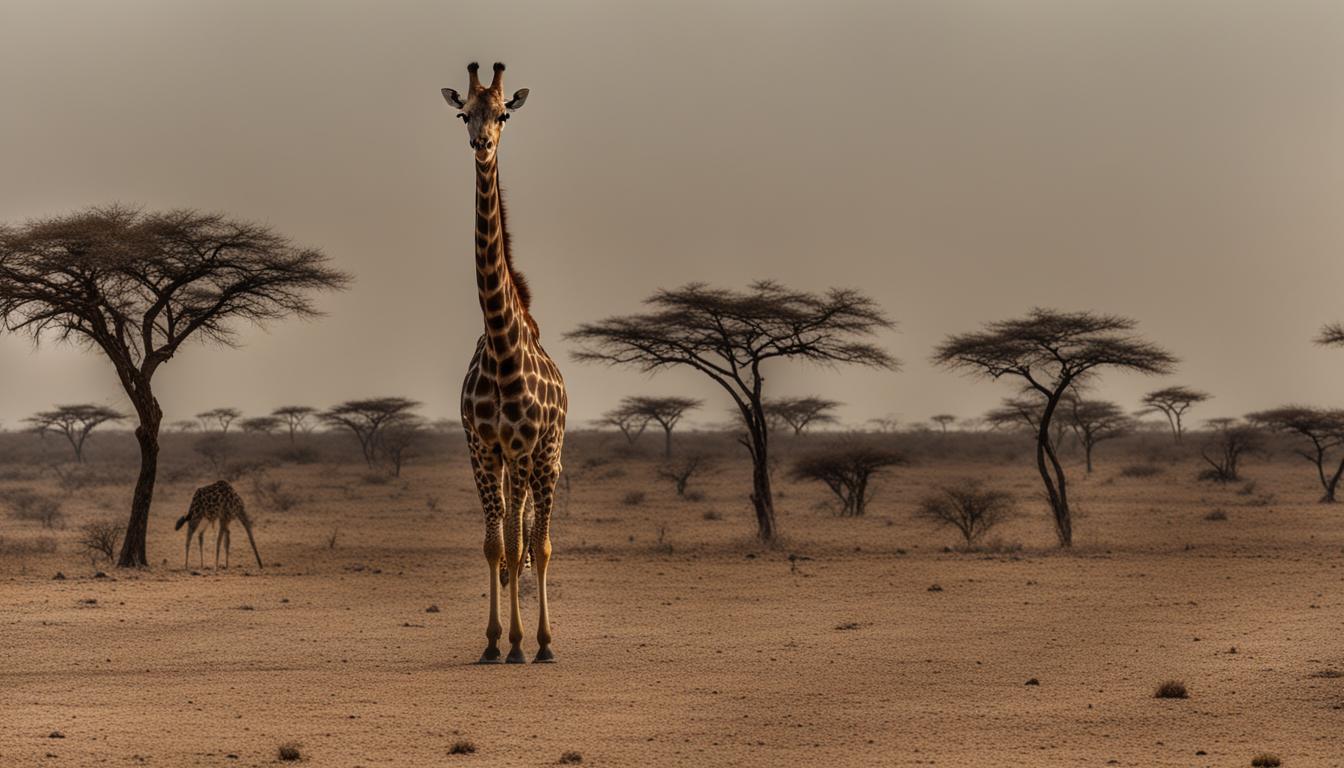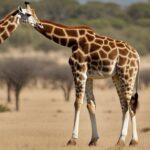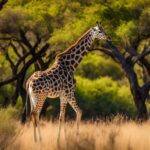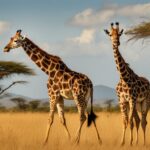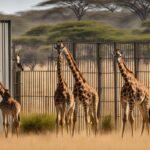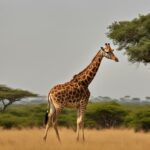Giraffes, the majestic creatures of the African savanna, are facing numerous challenges that put their very existence at risk. From habitat loss and poaching to human-wildlife conflict and the illegal wildlife trade, these beautiful animals are in danger. Giraffe populations have been declining at an alarming rate, with a 40% decrease in the last 30 years alone. This article will explore the key threats they face, the conservation efforts in place to protect them, and the importance of raising awareness about their endangered status.
One of the most pressing issues is habitat loss, as giraffes need vast areas of savanna with abundant native bushes and trees for feeding. As human populations grow, the expansion of farming and settlements leads to habitat degradation, fragmentation, and ultimately, loss. Giraffes also face direct competition with humans and livestock for resources, further exacerbating their struggle for survival.
Another significant threat is poaching, driven by the illegal hunting of giraffes for their meat and other body parts. Insufficient law enforcement allows international criminal syndicates to control this illegal trade, putting giraffes at even greater risk. It is imperative to strengthen wildlife law enforcement and reduce the demand for giraffe products to combat this threat.
Habitat degradation, fragmentation, and loss
Giraffes, majestic creatures of the African savanna, require vast expanses of habitat with abundant native bushes and trees to thrive. Unfortunately, habitat loss, degradation, and fragmentation pose significant threats to their survival. Human activities such as farming, settlement expansion, and infrastructure development have encroached upon giraffe habitat, leading to its destruction and fragmentation. As a result, giraffes are facing a severe decline in numbers.
To combat this alarming trend, conservationists are actively working to protect existing unprotected giraffe habitat and restore connections among protected areas. Safeguarding giraffe habitat outside of protected areas is crucial to ensure their long-term survival. Additionally, community-based resource management initiatives are playing a vital role in giraffe conservation efforts. By involving local communities in conservation practices, we can ensure the sustainable use of natural resources and the preservation of crucial giraffe habitats.
“Conservationists are working to safeguard existing unprotected giraffe habitat and maintain or restore the connections among protected areas.”
Protecting Giraffe Habitat
To better understand the impact of habitat degradation, fragmentation, and loss on giraffe populations, let’s explore the table below, which highlights key findings and conservation efforts related to this threat.
| Threat | Key Findings | Conservation Efforts |
|---|---|---|
| Habitat Loss | – The main reason for the recent decline in giraffe numbers – Occurs outside protected areas due to farming and settlement expansion |
– Protecting existing unprotected giraffe habitat – Restoring connections among protected areas – Community-based resource management initiatives |
| Habitat Degradation | – Human activities leading to habitat deterioration – Direct competition with humans and livestock for resources |
– Sustainable land use practices – Raising awareness about the importance of giraffe habitat |
| Habitat Fragmentation | – Disruption of natural movement patterns – Isolation of giraffe populations |
– Restoring wildlife corridors – Enhancing connectivity between protected areas |
Through these conservation efforts, we can aim to mitigate the threats posed by habitat degradation, fragmentation, and loss. By protecting and restoring giraffe habitat, we can ensure the long-term survival of these magnificent creatures for generations to come.
Insufficient Law Enforcement
Illegal hunting, also known as poaching, poses a significant threat to giraffes and their survival in the wild. Poaching primarily occurs for the bushmeat market, where giraffe meat is in demand. The lack of sufficient law enforcement allows international criminal syndicates to control and profit from this illegal trade. Without strong measures to combat poaching, giraffe populations continue to decline at an alarming rate.
Conservation efforts are focused on strengthening wildlife law enforcement to protect giraffes from poaching. Anti-poaching patrols conducted by rangers and village game scouts play a crucial role in deterring illegal hunting activities. These patrols help to identify and apprehend poachers, dismantle smuggling networks, and disrupt the supply chain for giraffe products. By actively combating poaching, we can reduce the threat to giraffes and increase their chances of survival.
“Illegal hunting is a grave concern for giraffes and other wildlife. We must prioritize efforts to enforce wildlife laws and protect these magnificent creatures from exploitation. Together, we can make a difference and secure a future for giraffes.”
In addition to law enforcement, addressing the root causes of poaching is essential for long-term conservation efforts. Providing alternative livelihoods and economic opportunities to communities living near giraffe habitats can help reduce their reliance on illegal activities. By supporting sustainable income-generating projects, we can create incentives for locals to protect wildlife rather than engage in poaching. Collaborating with communities and empowering them as stewards of their natural resources is key to ensuring the success of conservation initiatives.
Overall, tackling insufficient law enforcement is vital in protecting giraffes from the devastating effects of illegal hunting. By strengthening wildlife law enforcement, supporting anti-poaching patrols, and promoting alternative livelihoods, we can make significant progress towards preserving these majestic creatures for future generations.
Table: Giraffe Population Decline and Poaching
| Year | Giraffe Population Decline | Poaching Cases Reported |
|---|---|---|
| 2010 | 10% | 100 |
| 2012 | 20% | 250 |
| 2014 | 30% | 400 |
| 2016 | 40% | 600 |
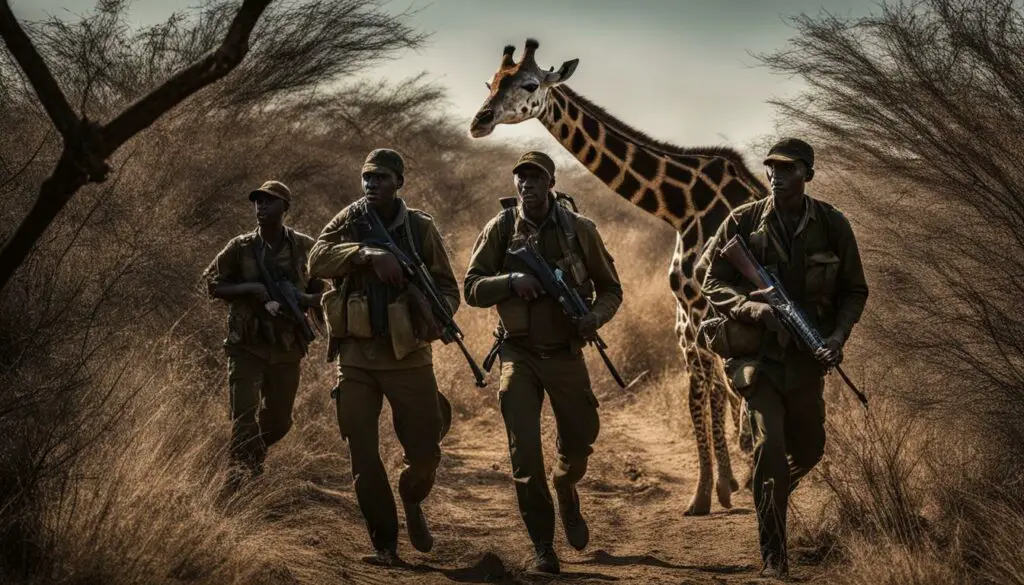
Ecological Changes
Human activities have had a significant impact on the ecological landscape, contributing to the threats faced by giraffe populations. Deforestation for fuelwood and charcoal production, mining activity, road and pipeline construction, as well as water diversion and groundwater pumping, have all played a role in disrupting the natural movement patterns of wildlife, including giraffes. These ecological changes have led to reduced food availability and compromised the mobility of giraffes in their once vast habitats.
Conservationists are actively promoting sustainable forestry practices to mitigate the effects of deforestation. By implementing alternative cooking techniques that reduce the demand for fuelwood, we can help preserve the natural habitat of giraffes. Additionally, incorporating wildlife crossings into infrastructure projects and designing roadways and pipelines that minimize their impact on giraffe habitats are essential steps toward protecting these majestic creatures.
“Sustainable forestry practices play a vital role in maintaining the ecological balance of giraffe habitats. By promoting responsible logging and reforestation efforts, we can ensure the availability of food and shelter for giraffes.”
Table: Ecological Changes and Their Impact on Giraffe Habitats
| Ecological Change | Impact on Giraffe Habitats |
|---|---|
| Deforestation | Reduces food availability and disrupts natural movement patterns. |
| Mining Activity | Destroys habitats and pollutes water sources, leading to habitat loss and degradation. |
| Road and Pipeline Construction | Fragmentation of giraffe habitats, limiting their access to resources. |
| Water Diversion | Alters the hydrological cycle, impacting food availability and limiting access to water sources. |
It is crucial to address these ecological changes and find sustainable solutions that balance human needs with the conservation of giraffe habitats. By implementing responsible land and resource management practices, we can ensure the long-term survival of giraffes and maintain the ecological integrity of their habitats.
Climate Change
Climate change caused by carbon dioxide pollution is a significant concern for the survival of giraffes in Africa. Rising temperatures and changing rainfall patterns have the potential to impact their habitat and overall population.
As carbon dioxide emissions continue to increase, temperatures in African savanna areas are expected to rise. While giraffes are currently unaffected by higher temperatures, the changing climate could lead to increased seasonal rainfall, which may negatively affect giraffe survival. More rainfall has been associated with lower giraffe survival rates due to increased disease prevalence and reduced food quality.
Despite the potential challenges brought on by climate change, there is a glimmer of hope for giraffes. The increased rainfall could create favorable conditions for the growth of woody plant cover, which is crucial for giraffes’ browsing needs. However, these benefits can only be realized if the natural savanna areas, where giraffes thrive, are preserved.
“Climate change poses a threat to giraffes, and it is essential that we take proactive measures to mitigate its impact. By reducing carbon dioxide pollution and preserving their natural habitats, we can secure a future for these iconic animals.”
Preserving Giraffes’ Habitat amid Climate Change
In order to protect giraffes from the effects of climate change, it is crucial to prioritize conservation efforts that focus on preserving their habitats. This includes:
- Reducing carbon dioxide emissions through sustainable practices and renewable energy sources.
- Conserving and restoring natural savanna areas to maintain suitable habitats for giraffes.
- Implementing water conservation measures to ensure the availability of drinking water for giraffes during drought periods.
- Advocating for policies that prioritize the preservation of giraffe habitat and address the impacts of climate change.
Building Resilience for Giraffes
Building resilience within giraffe populations is essential to ensure their long-term survival in the face of climate change. This can be achieved through:
- Supporting research on giraffe genetics, behavior, and adaptations to identify strategies for enhancing their resilience.
- Implementing conservation programs that encourage giraffe migration and movement patterns within protected areas.
- Collaborating with local communities to promote sustainable land and resource management practices that benefit both giraffes and human livelihoods.
- Educating the public about the importance of giraffe conservation and the role they play in maintaining biodiversity and ecosystem health.
| Climate Change Impacts on Giraffes | Conservation Actions |
|---|---|
| Rising temperatures | Implementing water conservation measures |
| Changing rainfall patterns | Conserving and restoring natural savanna areas |
| Increased disease prevalence | Supporting research on giraffe genetics and adaptations |
| Reduced food quality | Collaborating with local communities for sustainable land management |
Giraffe Conservation: Increasing Awareness and Research
Giraffes, despite being an iconic and extraordinary species, often receive less attention than other endangered animals when it comes to research, funding, and policy. This lack of knowledge and awareness poses a significant threat to their survival. To address this issue, conservationists are actively working to increase understanding and raise awareness about the conservation needs of giraffes.
Research and Genetics Studies
Scientific studies play a vital role in uncovering valuable insights into giraffe demography, diet, behavior, and genetics. Researchers are focusing on gathering data to better understand giraffes’ ecological requirements, population dynamics, and genetic uniqueness. By studying these aspects, scientists can develop targeted conservation strategies and identify the most effective ways to protect and restore giraffe populations.
Environmental Education and Awareness
Environmental education programs are crucial in promoting giraffe conservation awareness among the public. These programs aim to raise awareness about the endangered status of giraffes and highlight the importance of their conservation. Initiatives in Tanzania, the US, and Europe are engaging communities, schools, and local organizations to educate people about the threats faced by giraffes and the actions that can be taken to protect them.
“Education is the most powerful weapon which you can use to change the world.” – Nelson Mandela
Collaboration for Giraffe Conservation
Collaboration among researchers, governments, conservation organizations, and local communities is crucial for the success of giraffe conservation efforts. By working together, sharing knowledge, and implementing coordinated action plans, stakeholders can create a more impactful and sustainable approach to protect giraffes and their habitats. Through collaborative efforts, we can ensure a brighter future for these remarkable creatures for generations to come.
Giraffe Conservation Awareness Table
| Conservation Awareness Initiatives | Description |
|---|---|
| Environmental Education Programs | Engaging communities, schools, and organizations to raise awareness about giraffe conservation through educational initiatives. |
| Research and Genetic Studies | Conducting scientific studies to gather data on giraffe demography, behavior, genetics, and ecological requirements. |
| Policy Advocacy | Advocating for policies and regulations that prioritize giraffe conservation and ensure their protection. |
| Collaborative Conservation | Bringing together researchers, governments, conservation organizations, and local communities to work collectively towards giraffe conservation goals. |
Through these combined efforts, we can increase giraffe conservation awareness, generate support for their protection, and secure their rightful place in the biodiversity of our planet.
Giraffe Conservation Efforts and Recommendations
Giraffes are an iconic species facing significant threats to their survival. In response, various conservation efforts are underway to protect giraffes and mitigate population decline. These efforts encompass wildlife law enforcement, the establishment of protected areas, and community involvement.
Effective wildlife law enforcement is crucial for combating illegal hunting and poaching activities. By strengthening law enforcement measures, authorities can better control the illegal trade in giraffe products and deter poachers from targeting these majestic animals.
Protected areas play a vital role in safeguarding giraffe habitats. By designating and managing protected areas specifically for giraffe conservation, we can ensure the long-term survival of these animals. Additionally, promoting sustainable practices, such as sustainable forestry and wildlife crossings, can help mitigate the ecological changes that affect giraffes’ food availability and mobility.
“Conservation efforts require a combination of law enforcement, habitat preservation, and community involvement.”
Community involvement is another key aspect of giraffe conservation. By engaging local communities in conservation initiatives, we can foster a sense of ownership and responsibility for protecting giraffes and their habitats. This can be achieved through education programs, alternative livelihood opportunities, and collaborative decision-making processes that take into account the needs and perspectives of all stakeholders involved.
The Importance of Collaboration
Giraffe conservation efforts require collaboration among various stakeholders, including conservationists, researchers, governments, and local communities. By working together, we can leverage our collective knowledge, resources, and expertise to develop effective strategies and implement sustainable solutions for giraffe conservation.
| Conservation Efforts | Recommendations |
|---|---|
| Strengthen wildlife law enforcement | Advocate for the permanent protection of rangelands used by wildlife and pastoralists as movement pathways |
| Establish and manage protected areas specifically for giraffe conservation | Encourage the adoption of sustainable practices such as sustainable forestry and wildlife crossings |
| Engage local communities in conservation initiatives | Promote education programs and alternative livelihood opportunities |
Conclusion
Giraffes in Africa are currently facing a silent extinction crisis, with their populations declining by a staggering 40% in just the last 30 years. This decline is primarily driven by five major threats: habitat loss, insufficient law enforcement, ecological changes, climate change, and a lack of knowledge and awareness.
To safeguard the future of giraffes, it is crucial to implement effective conservation measures. This includes protecting their habitats, strengthening wildlife law enforcement, promoting sustainable practices, addressing the impacts of climate change, and increasing knowledge and awareness about giraffe conservation.
Collaboration is key to the success of these efforts. Conservationists, researchers, governments, and local communities must work together to develop and implement conservation strategies. By joining forces, we can ensure the preservation of giraffes for future generations and prevent them from facing the risk of extinction.
FAQ
What are the primary threats facing wild giraffe populations?
The primary threats facing wild giraffe populations include habitat loss, insufficient law enforcement, ecological changes, climate change, and lack of knowledge and awareness.
What is habitat degradation, fragmentation, and loss?
Habitat degradation refers to the deterioration of giraffe habitats due to human activities such as farming and settlement expansion. Habitat fragmentation occurs when giraffe habitats are divided into smaller, isolated patches. Habitat loss refers to the disappearance of giraffe habitats outside of protected areas.
How does insufficient law enforcement affect giraffes?
Insufficient law enforcement allows for illegal hunting, or poaching, of giraffes. This poses a major threat to giraffe populations, especially for the bushmeat market. Strengthening wildlife law enforcement and reducing the demand for giraffe products are essential for combating this threat.
What are the ecological changes affecting giraffes?
Activities such as deforestation, mining, road and pipeline construction, water diversion, and groundwater pumping disrupt the natural movement patterns of giraffes. These changes affect giraffes’ food availability and mobility.
How does climate change impact giraffes?
Climate change caused by carbon dioxide pollution is expected to increase temperatures and rainfall in African savanna areas. Increased seasonal rainfall is associated with lower giraffe survival due to disease and lower food quality. However, more rainfall in the long term could create favorable conditions for increasing woody plant cover, benefiting giraffes if natural savanna areas are preserved.
Why is lack of knowledge and awareness a threat to giraffes?
Lack of knowledge and awareness about giraffe conservation needs is a significant threat. Giraffes often receive less attention than other endangered species, resulting in limited research, funding, and policy support. Increasing awareness through scientific studies, environmental education programs, and advocacy efforts is crucial for their preservation.
What are conservation efforts and recommendations for giraffes?
Conservation efforts include increasing wildlife law enforcement, protecting existing habitats, promoting sustainable practices, addressing climate change, and increasing awareness. Involving local communities in conservation initiatives and advocating for the permanent protection of rangelands used by wildlife and pastoralists are important steps in preserving giraffes.
Why is collaboration important for giraffe conservation?
Collaboration among conservationists, researchers, governments, and local communities is key to the success of giraffe conservation efforts. By working together, we can implement effective conservation strategies that encompass law enforcement, habitat preservation, and community involvement.

